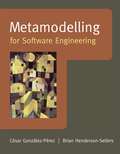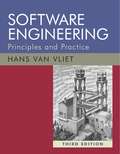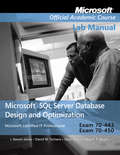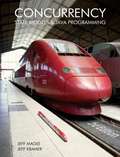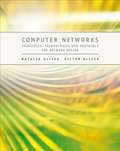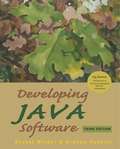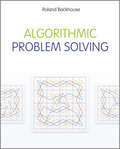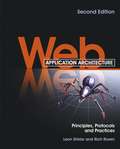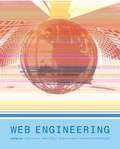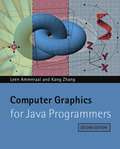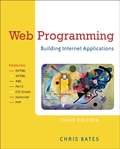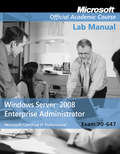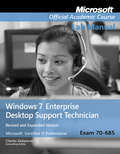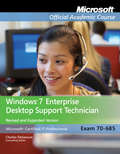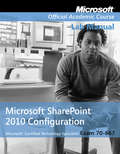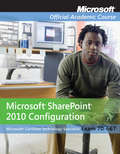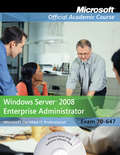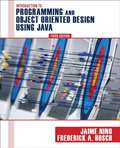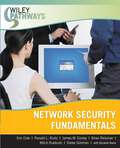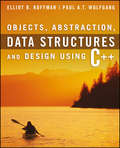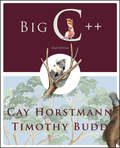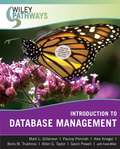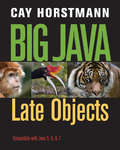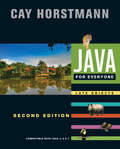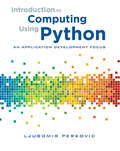- Table View
- List View
Metamodelling for Software Engineering
by Cesar Gonzalez-Perez Brian Henderson-SellersThis book focuses on metamodelling as a discipline, exploring its foundations, techniques and results. It presents a comprehensive metamodel that covers process, product and quality issues under a common framework. Issues covered include: An explanation of what metamodelling is and why it is necessary in the context of software engineering. Basic concepts and principles of traditional metamodelling, and some existing results of this approach. Problems associated with traditional approaches to Metamodelling are discussed, alongside an exploration of possible solutions and alternative approaches. Advanced topics such as the extension of the object-oriented paradigm for metamodelling purposes or the foundations of powertype-based tool development will be studied. Finally, a comprehensive case study is introduced and developed, showing how to use many of the concepts explained in the previous chapters. This book provides a comprehensive conceptual framework for metamodelling and includes case studies and exercises which will demonstrate practical uses of metamodelling. For lecturers and educators, the book provides a layered repository of contents, starting from the basics of metamodelling in the first chapters, through specific issues such as trans-layer control or non-strict approaches, up to advanced topics such as universal powertyping or extensions to the object-oriented paradigm. The book also serves as an in-depth reference guide to features and technologies to consider when developing in-house software development methods or customising and adopting off-the-shelf ones. Software tool developers and vendors can benefit from the book by finding in it a comprehensive guide to the implementation of frameworks and toolsets for computer-aided software modelling and development.
Software Engineering: Principles and Practice
by Hans Van VlietIn-depth coverage of the latest advances in software engineering Aimed at defining inherent problems and providing appropriate solutions when constructing large software systems, the study of software engineering is an essential practice in order to create and maintain successful software development. This new edition shows you how to appreciate the issues, design trade-offs, and teamwork required for successful software development. With a special emphasis placed on the managerial aspects and human factors involved in software projects, this book reflects the changes taking place within software engineering and includes a major update on architecture and the increasingly hybrid character of software engineering. Offers comprehensive coverage of the fundamentals of software engineering as well as revised and updated text on the latest advances in the field, including agile methods, open source, and UML2 Incorporates discussion of commercial off-the-shelf products and open source Examines the impact of lightweight versus heavyweight methods, paying particular attention to agile approaches Addresses the globalization of software development and the impact of the Web This new edition is an invaluable resource for anyone involved in software development and maintenance.
Exam 70-443 & 70-450 Microsoft SQL Server Database Design and Optimization Lab Manual
by Microsoft Official Academic CourseThis course in the Microsoft Official Academic Course program prepares students for exam 70-443/450, Microsoft SQL Server Database Design and Optimization.
Concurrency: State Models and Java Programs
by Jeff Magee Jeff KramerConcurrency provides a thoroughly updated approach to the basic concepts and techniques behind concurrent programming. Concurrent programming is complex and demands a much more formal approach than sequential programming. In order to develop a thorough understanding of the topic Magee and Kramer present concepts, techniques and problems through a variety of forms: informal descriptions, illustrative examples, abstract models and concrete Java examples. These combine to provide problem patterns and associated solution techniques which enable students to recognise problems and arrive at solutions. New features include: New chapters covering program verification and logical properties. More student exercises. Supporting website contains an updated version of the LTSA tool for modelling concurrency, model animation, and model checking. Website also includes the full set of state models, java examples, and demonstration programs and a comprehensive set of overhead slides for course presentation.
Computer Networks: Principles, Technologies and Protocols for Network Design
by Natalia Olifer Victor OliferThis is a comprehensive guide covering both the theory of basic networking technologies as well as practical solutions to networking problems. Networking concepts explained plainly with emphasis on how networks work together Practical solutions backed up with examples and case studies Balance of topics reflects modern environments Instructor and Student book site support including motivational courseware
Developing Java Software
by Russel Winder Graham RobertsThis significantly updated new edition of Developing Java Software is a thorough presentation of object-oriented design and programming concepts using the Java 5 programming language. The book takes the reader from the basics of using Java 5 to the creation of complete, object-oriented programs. Following an ‘objects early’ approach, the core elements of the Java language are covered, including the use of recently added features such as generics. The encouragement of the proper creation and use of classes, and the demonstration of the strategies used to create good quality code are at the core of this book. You will learn how Java programs work and how they can be designed and implemented in an organized and systematic way. In addition, the book addresses how a Java programming project should be managed and introduces the Ant build tool and the Subversion version control system. Testing has always been an important part of Developing Java Software. This edition provides new chapters which give a detailed introduction to Test-driven Development (TDD). This approach to programming introduces more rigor to writing programs by placing emphasis on writing high quality testable and tested code from the outset. A series of examples and case studies shows how TDD works and highlights the strategies for testing code. Reflecting recent changes to the Java programming language and newly focused on first courses in programming, this excellent primer is ideal for classroom use or self-study. The many motivating examples and larger case studies show how core ideas can be applied when creating real applications, and show how to use object-oriented methods effectively to create robust, reliable, and fully-tested Java applications.
Algorithmic Problem Solving
by Roland BackhouseAn entertaining and captivating way to learn the fundamentals of using algorithms to solve problems The algorithmic approach to solving problems in computer technology is an essential tool. With this unique book, algorithm guru Roland Backhouse shares his four decades of experience to teach the fundamental principles of using algorithms to solve problems. Using fun and well-known puzzles to gradually introduce different aspects of algorithms in mathematics and computing. Backhouse presents you with a readable, entertaining, and energetic book that will motivate and challenge you to open your mind to the algorithmic nature of problem solving. Provides a novel approach to the mathematics of problem solving focusing on the algorithmic nature of problem solving Uses popular and entertaining puzzles to teach you different aspects of using algorithms to solve mathematical and computing challenges Features a theory section that supports each of the puzzles presented throughout the book Assumes only an elementary understanding of mathematics Let Roland Backhouse and his four decades of experience show you how you can solve challenging problems with algorithms!
Web Application Architecture: Principles, Protocols and Practices
by Leon Shklar Rich RosenIn-depth examination of concepts and principles of Web application development Completely revised and updated, this popular book returns with coverage on a range of new technologies. Authored by a highly respected duo, this edition provides an in-depth examination of the core concepts and general principles of Web application development. Packed with examples featuring specific technologies, this book is divided into three sections: HTTP protocol as a foundation for Web applications, markup languages (HTML, XML, and CSS), and survey of emerging technologies. After a detailed introduction to the history of Web applications, coverage segues to core Internet protocols, Web browsers, Web application development, trends and directions, and more. Includes new coverage on technologies such as application primers, Ruby on Rails, SOAP, XPath, P3P, and more Explores the fundamentals of HTTP and its evolution Looks at HTML and its roots as well as XML languages and applications Reviews the basic operation of Web Servers, their functionality, configuration, and security Discusses how to process flow in Web browsers and looks at active browser pages Addresses the trends and various directions that the future of Web application frameworks may be headed This book is essential reading for anyone who needs to design or debug complex systems, and it makes it easier to learn the new application programming interfaces that arise in a rapidly changing Internet environment.
Web Engineering: The Discipline of Systematic Development of Web Applications
by Gerti Kappel Birgit Pröll Siegried Reich Werner RetschitzeggerThe World Wide Web has a massive and permanent influence on our lives. Economy, industry, education, healthcare, public administration, entertainment – there is hardly any part of our daily lives which has not been pervaded by the Internet. Accordingly, modern Web applications are fully-fledged, complex software systems, and in order to be successful their development must be thorough and systematic. This book presents a new discipline called Web Engineering taking a rigorous interdisciplinary approach to the development of Web applications, covering Web development concepts, methods, tools and techniques. It highlights the need to examine and re-use the body of knowledge found within software engineering and demonstrates how to use that knowledge within the Web environment, putting emphasize on current practices, experiences and pitfalls. The book is ideal for undergraduate and graduate students on Web-focused or Software Engineering courses, as well as Web software developers, Web designers and project managers.
Computer Graphics for Java Programmers
by Leen Ammeraal Kang ZhangA great many varied and interesting visual effects can be achieved with computer graphics, for which a fundamental understanding of the underlying mathematical concepts – and a knowledge of how they can be implemented in a particular programming language – is essential. Computer Graphics for Java Programmers, 2nd edition covers elementary concepts in creating and manipulating 2D and 3D graphical objects, covering topics from classic graphics algorithms to perspective drawings and hidden-line elimination. Completely revised and updated throughout, the second edition of this highly popular textbook contains a host of ready-to-run-programs and worked examples, illuminating general principles and geometric techniques. Ideal for classroom use or self-study, it provides a perfect foundation for programming computer graphics using Java.
Web Programming: Building Internet Applications
by Chris BatesWeb programming is about more than creating and formatting webpages and websites, though that is often a starting point for many. Using scripting languages such as JavaScript, Perl and PH, it becomes possible to add a lot more functionality to a site. This book teaches the essentials of working with the most important web technologies. From client development using HTML and Javascript, through to full server side applications written in ASP and Perl, the complete web system is shown. Concentrating on immediately useful code rather than theory, this is a how-to book for practical and project based courses. The broad scope covered by this book begins by creating reasonably simple webpages with HTML, then working through related document and content tagging systems such as dynamic HTML and eventually XML.
Exam 70-647 Windows Server 2008 Enterprise Administrator Lab Manual
by Microsoft Official Academic CourseExam 70-647, Windows Server 2008 Enterprise Administrator. The newest iteration of the Microsoft Official Academic Course (MOAC) program for network administration courses using Windows Server 2008 and mapping to the Microsoft Certified Information Technology Professional (MCITP) 70-647 certification exam. The MOAC IT Professional series is the Official from Microsoft, turn-key Workforce training program that leads to professional certification and was authored for college instructors and college students. MOAC gets instructors ready to teach and students ready for work by delivering essential resources in 5 key areas: Instructor readiness, student software, student assessment, instruction resources, and learning validation. With the Microsoft Official Academic course program, you are getting instructional support from Microsoft; materials that are accurate and make course delivery easy. Request your sample materials today.
Exam 70-685 Windows 7 Enterprise Desktop Support Technician Revised and Expanded Version Lab Manual (Microsoft Official Academic Course Series)
by Microsoft Official Academic CourseThis is the lab manual designed to accompany Exam 70-685 Windows 7 Enterprise Desktop Support Technician Revised and Expanded Version
Exam 70-685: Windows 7 Enterprise Desktop Support Technician (Microsoft Official Academic Course Series)
by Microsoft Official Academic CourseThis Microsoft Official Academic Course (MOAC) 70-685 Windows 7 Enterprise Desktop Support Technician, Revised First Edition fully prepares your students as they master the necessary skills for their MOAC Windows Server MCTS certification exam. This new edition contains a large number of new labs with an even greater emphasis on the troubleshooting tasks that students will encounter as they learn the skills of a desktop support technician. The labs will continue to support their corresponding textbook lessons and will provide students the opportunity to explore Windows 7 troubleshooting issues in great detail.
Exam 70-667 Microsoft Office SharePoint 2010 Configuration Lab Manual
by Microsoft Official Academic CourseThis book is for students preparing to become certified for the 70-630, Microsoft Office SharePoint Server 2007 Configuration exam. The Microsoft Official Academic Course (MOAC) lessons correlate and are mapped to the Microsoft Certified Technology Specialist (MCTS) 70-630 certification exam. This text covers facilitating collaboration, understanding content management features, implementation of business processes, and supplying access to information essential to organizational goals and processes. Students master skills to utilize SharePoint sites that support specific content publishing, content management, records management, and business intelligence needs. The MOAC IT Professional series is the Official from Microsoft, turn-key Workforce training program that leads to professional certification and was authored for college instructors and college students.
Exam 70-667: Microsoft Office SharePoint 2010 Configuration
by Microsoft Official Academic CourseThis book is for students preparing to become certified for the 70-667, Microsoft Office SharePoint Server 2007 Configuration exam. The Microsoft Official Academic Course (MOAC) lessons correlate and are mapped to the Microsoft Certified Technology Specialist (MCTS) 70-667 certification exam. This text covers facilitating collaboration, understanding content management features, implementation of business processes, and supplying access to information essential to organizational goals and processes. Students master skills to utilize SharePoint sites that support specific content publishing, content management, records management, and business intelligence needs. The MOAC IT Professional series is the Official from Microsoft, turn-key Workforce training program that leads to professional certification and was authored for college instructors and college students. MOAC gets instructors ready to teach and students ready for work by delivering essential resources in 5 key areas: Instructor readiness, student software, student assessment, instruction resources, and learning validation. With the Microsoft Official Academic course program, you are getting instructional support from Microsoft; materials that are accurate and make course delivery easy.
Exam 70-647: Windows Server 2008 Enterprise Administrator
by Microsoft Official Academic CourseThe newest iteration of the Microsoft Official Academic Course (MOAC) program for network administration courses using Windows Server 2008 and mapping to the Microsoft Certified Information Technology Professional (MCITP) 70-647 certification exam. The MOAC IT Professional series is the Official from Microsoft, turn-key Workforce training program that leads to professional certification and was authored for college instructors and college students. MOAC gets instructors ready to teach and students ready for work by delivering essential resources in 5 key areas: Instructor readiness, student software, student assessment, instruction resources, and learning validation. With the Microsoft Official Academic course program, you are getting instructional support from Microsoft; materials that are accurate and make course delivery easy.
Introduction to Programming and Object-Oriented Design Using Java
by Jaime Niño Frederick A. HoschThe 3rd edition of Introduction to Programming and Object-Oriented Design continues to provide students with an objects first introduction to programming and software design using Java. Java is used as a vehicle for teaching problem modeling using fundamental software engineering principles and concepts. The text has been updated to include more problems and exercises and additional relevant examples. It also offers optional, interactive exercises using the DrJava integrated development environment (IDE). The UML is employed (very informally) for denoting objects, object relationships, and system dynamics. No specific previous programming experience is assumed, and the text is appropriate for first year computer science majors. The text could also carry over to a second course on data structures or software/OO design.
Wiley Pathways Network Security Fundamentals
by Eric Cole Ronald L. Krutz James Conley Brian Reisman Mitch Ruebush Dieter Gollmann Rachelle ReeseThis text provides an overview of all the key security topics including physical security, cryptography, authentication, access control, remote access and wireless security, securing servers, viruses, intrusion detection, disaster recovery, and management principles needed for setting up and maintaining network security.
Objects, Abstraction, Data Structures and Design: Using C++
by Elliot B. Koffman Paul A. Wolfgang"It is a practical book with emphasis on real problems the programmers encounter daily." --Dr.Tim H. Lin, California State Polytechnic University, Pomona "My overall impressions of this book are excellent. This book emphasizes the three areas I want: advanced C++, data structures and the STL and is much stronger in these areas than other competing books." --Al Verbanec, Pennsylvania State University Think, Then Code When it comes to writing code, preparation is crucial to success. Before you can begin writing successful code, you need to first work through your options and analyze the expected performance of your design. That's why Elliot Koffman and Paul Wolfgang's Objects, Abstraction, Data Structures, and Design: Using C++ encourages you to Think, Then Code, to help you make good decisions in those critical first steps in the software design process. The text helps you thoroughly understand basic data structures and algorithms, as well as essential design skills and principles. Approximately 20 case studies show you how to apply those skills and principles to real-world problems. Along the way, you'll gain an understanding of why different data structures are needed, the applications they are suited for, and the advantages and disadvantages of their possible implementations. Key Features * Object-oriented approach. * Data structures are presented in the context of software design principles. * 20 case studies reinforce good programming practice. * Problem-solving methodology used throughout... "Think, then code!" * Emphasis on the C++ Standard Library. * Effective pedagogy.
Big C++
by Cay S. Horstmann Timothy A. BuddBig C++ focuses on practical program development and effective use of the C++ programming language. It is suitable for motivated beginners as well as students with prior programming experience. Horstmann and Budd combine their professional and academic experience to guide the student from the basics to more advanced topics and contemporary applications such as GUIs and XML programming. More than a reference, Big C++ provides well-developed exercises, examples, and case studies that engage students in the details of useful C++ applications.
Wiley Pathways Introduction to Database Management
by Mark L. Gillenson Paulraj Ponniah Alex Kriegel Boris M. Trukhnov Allen G. Taylor Gavin Powell Frank MillerIntroduction to Databases walks learners through databases, SQL language database management systems, as well as illustrates how to recognize critical business information, design a database, and retrieve and modify information in a useful manner.
Big Java: Late Objects
by Cay S. HorstmannBig Java: Late Objects is a comprehensive introduction to Java and computer programming, which focuses on the principles of programming, software engineering, and effective learning. It is designed for a two-semester first course in programming for computer science students.
Java For Everyone: Late Objects
by Cay S. HorstmannJava For Everyone, 2nd Edition is a comprehensive introduction to Java and computer programming, which focuses on the principles of programming, software engineering, and effective learning. It is designed for a one-semester, mixed-major, first course in programming. Nobody supports your desire to teach students good programming skills like Cay Horstmann. Active in both the classroom and the software industry, Horstmann knows that meticulous coding-not shortcuts-is the base upon which great programmers are made. Using an innovative visual design that leads students step-by-step through intricacies of Java programming, Java For Everyone, 2nd Edition instills confidence in beginning programmers and confidence leads to success.
Introduction to Computing Using Python: An Application Development Focus
by Ljubomir PerkovicPerkovic's Introduction to Programming Using Python is more than just an introduction to programming. It is an inclusive introduction to Computer Science that takes the pedagogical approach of "the right tool for the job at the right moment," and focuses on application development. The approach is hands-on and problem-oriented, with practice problems and solutions appearing throughout the text. The text is imperative-first, but does not shy away from discussing objects early where appropriate. Discussions of user-defined classes and Object-Oriented Programming appear later in the text, when students have more background and concepts can be motivated. Chapters include an introduction to problem solving techniques and classical algorithms, problem-solving and programming and ways to apply core skills to application development.
